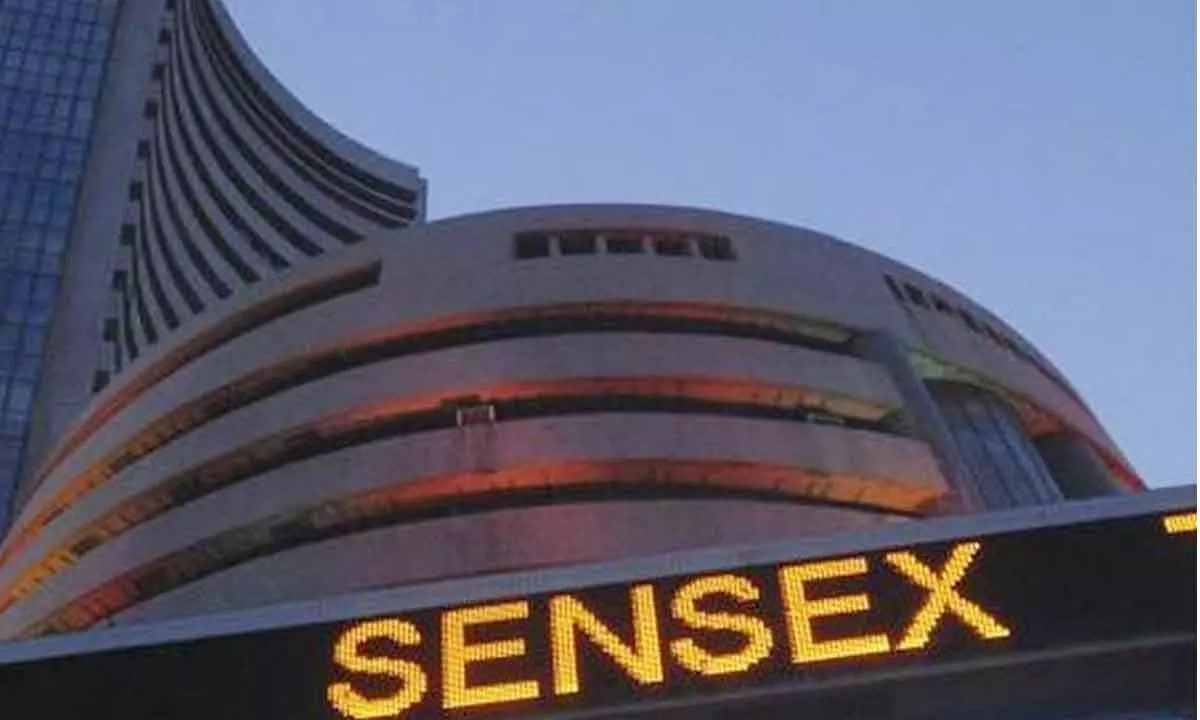Undercurrent bullish mode may continue in short-term

BSE Sensex
FIIs divested `9,978.26 crore, while DIIs invested `8,055.05 cr in Oct so far
Amidst heightened volatility on the back of mixed negative domestic as well as international cues; the domestic stock markets witnessed bouts of selling from foreign institutional investors (FIIs). Buying support from domestic investors, falling crude oil prices and a good start to the quarterly earnings season, however, helped the benchmark indices trim some losses. For the week ended, BSE Sensex shed 271.32 points or 0.46 percent to close at 57,919.97 points, while NSE Nifty fell 128.95 points or 0.74 percent to end at 17,185.7 level. The BSE Smallcap index shed 2.2 percent and Midcap 2.6 percent. Among sectors, the Nifty Realty index shed 4.2 percent, Media index fell 3.6 percent and Energy index lost 3 percent. However, the Nifty Information Technology index added 0.8 percent. FIIs sold equities worth Rs9,941.71 crore, while DIIs pumped in Rs7,030.96 crore. Till date in October, FIIs divested Rs9,978.26 crore, while DIIs invested Rs8,055.05 crore. The rupee ended at a record closing low of 82.3500/USD. So far in October, the dollar index rose one per cent. Observers say that the rupee depreciation against US Dollar can continue for some more time till US Fed keeps tightening liquidity conditions. It is pertinent to observe that in comparison to Euro, Pound, Chinese Yuan, or Japanese Yen; the rupee has outperformed in the last one year since Indian economic fundamentals remain strong, versus these economies which should continue in the future as well. Near term direction of the market will be dictated by Q2 earnings, macroeconomic data, rupee-dollar movement, international crude oil prices and global cues. Coming week would see many financial and cement companies reporting their Q2 results. Results to watch out for are from ACC, Asian Paints, Axis Bank, Bajaj Finance, InduSind Bank, ITC, Tata Consumer, Nestle, RIL, Havells and Ultratech. The sectors which are expected to outperform in coming few weeks are IT, Pharma, FMCG, Consumer Durables and Specialty Chemicals. Market players expect the bullish undercurrent to continue in the short-term. Adopt 'Buy at a dip' strategy with a focus on domestic economy-oriented stocks and sectors.
Listening Post: Are those who can't remember the crash condemned to repeat it? Markets have been recovering with whipsaw moves and investors returning to stocks, thanks to an epidemic of amnesia. Many investors have been behaving as if the bloodbath between October 2007 and March 2009 or at the start of 2020 Covid pandemic, when the global stock markets lost at least 40 per cent, had never happened. More worrisome, investors are forgetting the agonizingly real fear they felt during the financial crisis. That could lead some to take more risk than they should
and incur losses they can't withstand. So it is vital to evaluate whether you suffer from investing amnesia and, if you are, to counteract it before it is too late. There isn't any doubt that individual investors have been getting more aggressive. People are revising their memory of the financial crisis, as if they were looking into a rear-view mirror made of rose-colored glass.
Financial planners report that clients are increasingly saying 2008 and 2009 were no big deal. You might think memory works like an engraving plate onto which events are carved in stone and preserved for decades until they fade with age. In reality, psychologists have shown, memory works more like an Etch A Sketch, on which events are traced, but then often altered or erased entirely. People are prone to spontaneous distortions of memory that make us feel better about ourselves. Studies have shown, for example, that people remember voting regularly in national elections even when they haven't cast a ballot in at least six years and that 71 per cent of students who earned D grades in high school later recall getting higher marks. That's exactly the kind of polishing of the past that seems to be going on in many investors' minds right now. Because memory is so malleable, investors should keep an investment diary, creating a record of their buying and selling decisions and the reasons behind them. You can mitigate the flaws of memory by writing events down as they happen. You shouldn't trust your recollections of how you felt in 2008 and 2009 or during the first quarter of 2020. Instead, ask your spouse or a close friend how afraid you were, and look at your old account statements to see whether you sold at the bottom. The best guide to how you will act in the next market downturn is how you did act in the last one. The great financial analyst Benjamin Graham wrote in his book 'The Intelligent Investor,' after which this column is named, that "the investor's chief problem—and even his worst enemy—is likely to be himself. If you can't remember the pain you felt in the past when you lost money, you will have no one to blame, but yourself if you end up feeling the same anguish all over again.
Quote of the week: "We don't prognosticate macroeconomic factors, we're looking at our companies from a bottom-up perspective on their long-run prospects of returning — Mellody Hobson
It's very difficult to predict when the next recession or stock market crash will come, so many of the best investors don't even try. Instead, look for good companies with the strength to make it through the occasional challenging economic environment.
F&O / SECTOR WATCH
Under the shadow of fears of a recession in the developed countries, mixed corporate earnings and weak economic data; the derivatives segment witnessed highly volatile trading week. Nifty had a roller coaster ride in broader range of 16950 to17350, while Bank Nifty also traded in a broader range of 38450 to 39550 levels. The maximum Call Open Interest was at 18,000 strike followed by 17,500 strike and the maximum Put Open Interest was at 17,000 strike followed by 16,000 and 16,500 strikes. Call writing was seen at 17,300 strike and Put writing 16900 strike. Implied Volatility (IV) of Calls closed at 19.34 per cent, while that for Put option, it closed at 20.37 per cent. The Nifty VIX for the week closed at 20.29 per cent. PCR of OI for the week closed at 1.73. The volatility index India VIX cooled below 20 level last week, falling nearly three percent to 18.26 level. A further fall may bring stability to the market. If the Nifty sustains the level of 17,200, it may rally to 17,400-17,500, while a breach of 17,150 will see the index slide to 16,900. Overall options data indicates that the Nifty may remain in a broader trading range of 16,800-17,700, while the immediate range could be 17,000-17,500.
Ongoing Q2 results season will continue to trigger sharp stock-specific performance in individual stocks after the announcement of the actual results. The key focus area during the week would be the management commentary on trends across sectors, which could give the market some kind of direction. Over the weekend, HDFC Bank reported a consolidated net profit of Rs11,125 crore for the September quarter, up 22.3 percent from the year-ago period. The largest private bank reported a 23 percent loan growth and pristine asset quality during the July-September period.
Stay overweight on the banking sector say industry watchers. Ahead of the festive season, auto stocks continued to exhibit short term weakness. However, contrarians say that the sector is still showing higher relative strength against the benchmark indices and is now prepped for fresh rally. Stay invested in Autos and Auto ancillary space. Stock futures looking good are AU Small Finance, Axis Bank, Britannia, Bajaj Finserv, Sun Pharma, Federal Bank and Polycab India. Stock futures looking weak are Astral, Balrampur Chini, Coromandel, Dalmia Bharat, Naukri and Whirlpool.















